Berlin August 2007

I hadn't visited Berlin in 8 years and decided to take a long weekend trip to see how I liked the city since my last trip in 1999.
One of Berlin's biggest attractions in 2007 has been KNUT - the polar bear.
Born in December 2006, Knut the polar bear cub was rejected by his mother. The cub was adopted by a zookeeper who moved into the animal's enclosure to care for him round the clock. An international media sensation exploded after an animal rights activist was alleged to have said that the cub should be allowed to die rather than be brought up by humans.
"Hand-rearing a polar bear is not appropriate and is a serious violation of animal rights," Bild newspaper quoted animal rights campaigner Frank Albrecht as saying. "In fact, the cub should have been killed," he added.
The comments, the photos of the playful cub and the first public appearance of Knut in March 2007 catapulted the bear to a level of fame many stars would envy.
Berlin zoo made Knut's name a trademark and he's become an unofficial Berlin city mascot.
So the morning after my arrival in Berlin I took a stroll to the zoo to see Knut and his friends. My he's grown, as you can see from the photo. He has quite a few bear friends in the zoo too!
After the zoo I went to see the memorial of the Gedaechniskirche in the middle of Berlin. The church was built between 1891 und 1895 and destroyed in a bombing in 1943. After plans to demolish the church were revealed in the 1950s there was a storm of protests by the citizens of Berlin. The church was conserved and the new church beside it was built from 1959 to 1961.
Berlin's most famous landmark is the Brandenburg Gate which was built about 200 years ago. Until 1989 it was the symbol of divided Berlin and Germany and today it has become the national symbol of unity. The Brandenburg Gate is the only remaining city gate of Berlin. It was designed by Carl Gotthard Langhans in 1789 to 1791 as the first important example of Berlin Classicism. Langhans modelled the gate after the famous Propylaeum in Athens. The so called Quadriga (four-horsed chariot on top) and the ornamentation was designed by Johann gottfried Schadow. An iron cross (design: Friedrich Schinkel) was added to the goddess of peace, standing upon a chariot after the defeat of Napoleon. The Brandenburg Gate's design has remained unchanged since its completion, yet it has played different political roles in German history. After the 1806 Prussian defeat at the Battle of Jena-Auerstedt, Napoleon took the Quadriga to Paris, however, after his defeat in 1814 and the Prussian Parisian occupation by General Ernst von Pfuel, the Quadriga was restored to Berlin, and Viktoria's olive wreath exchanged for the Iron Cross, becoming goddess of victory.
Just beyond the Brandenburg Gate in what was former East Berlin a number of tour companies offer guides to the city. I tagged along on one tour that took us to the Jewish Holocaust memorial as a first stop.
The site is almost 5 acres of concrete slabs or stelae of varied sizes, 2711 in total. According to Eisenman's project text, the stelae are designed to produce an uneasy, confusing atmosphere, and the whole sculpture aims to represent a supposedly ordered system that has lost touch with human reason. A 2005 copy of the Foundation for the Memorial's official English tourist pamphlet, however, states that the design represents a radical approach to the traditional concept of a memorial, partly because Eisenman did not use any symbolism.
There's been some controversy regarding the memorial. Some questioned the singling out of Jewish victims of the holocaust when so many others suffered at the hands of the Nazis. Some feel there is an 'industry of shame' that exploits the Nazi atrocities to perpetuate Germany's disgrace. In an embarrassing irony, the company that made the anti-graffiti coating for the concrete had been involved in producing the Zyklon B gas used in the gas chambers during the Second World War. Most Jewish organisations spoke out against the company's involvement with the memorial, so the question of the purpose of the memorial is a meaningful one.
Nearby is the new British Embassy, and what a funky design it is! In 1991 the Bundestag voted to move the seat of Government from Bonn to Berlin. Following this historic decision, the British Government decided to return its embassy to its pre-War site on Wilhelmstraße, next door to the Hotel Adlon and close to the Brandenburg Gate. As you can see in the photo it is most eye-catching, and makes my just a little proud to be British.
Moving on we visited the site of Hitler's underground bunker and then on to Checkpoint Charlie, a tourist magnet. Checkpoint Charlie was the Allied name given to a crossing point between East Berlin and West Berlin during the Cold War, in the Friedrichstadt which was divided by the Berlin Wall. Checkpoint Charlie was designated as the single crossing point (by foot or by car) for foreigners and members of the Allied forces and became a symbol of the Cold War, representing the separation of east and west, and a gateway to freedom for some East Germans.
Checkpoint Charlie was initially blocked only by a gate until an East German smashed a car through it to escape. A strong pole was erected. Another escapee approached the barrier in a convertible, took the windscreen down at the last moment and slipped under the barrier. This was repeated two weeks later, so the East Germans lowered the barrier and added uprights.
After reunification developers tore down the East German checkpoint watchtower in 2000. This symbol of the Cold War was removed quietly so as to attract a minimum amount of attention. Most of the Berlin Wall was torn down during reunification, so a couple of stretches of wall were 'preserved' as a memorial. Bizarrely, the wall that divided East and West now has to be protected from souvenir hunters with a metal fence.
It's important to realise that after the Second World War Berlin was divided into four zones; British, American, French and Soviet (why the French were given a zone escapes me as they spent much of the war occupied by the Nazis, but more on the French on my 'random thoughts' page). Originally there was nothing to prevent from going to West Berlin, but the East German exodus prompted the eventual erection of the Berlin Wall. The construction began on August 13th, 1961, just a few days after I was born, eventually enclosing West Berlin. It wasn't until Hungary removed it's border restriction with Austria in August 1989 that virtual cracks in the Wall first appeared. Demonstrations in East Germany followed, more 'refugees' left through the relaxed Czechoslovakian border, and this persuaded the East German authorities to allow refugees to leave through East German border crossings. After a press conference on November 9th 1989, East Germans massed in their thousands, overwhelmed the border guards, and the wall became history.
There are still some Soviet icons to be seen if you look for them, as my photo of a wall plaque of Lenin on an East Berlin building off Wilhelmstraße near the British Embassy shows. The controversy surrounding old soviet imagery continues.
The final stop on my tour (after I slipped away for a coffee, delicious chocolate cake and some souvenir shopping) was the Reichstag building, the home of the parliament of the German Empire.
In 1933 the building was set on fire and and gave the Nazis and excuse to suspend a number of constitutional human rights. Further damaged by air raids the building remained in ruins until reconstruction in 1961 and again in 1999.
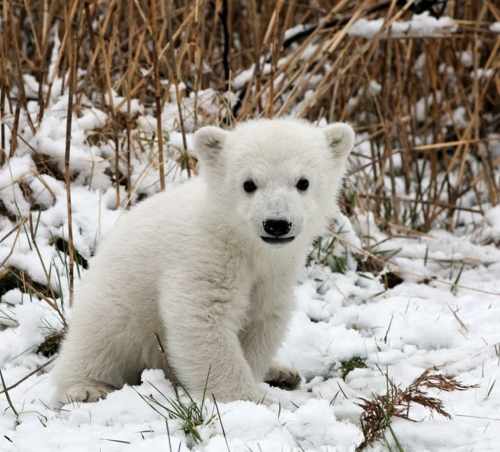
A Berlin Zoo photo of Knut shortly after he was born

Another Berlin Zoo photo of Knut posing for the camera
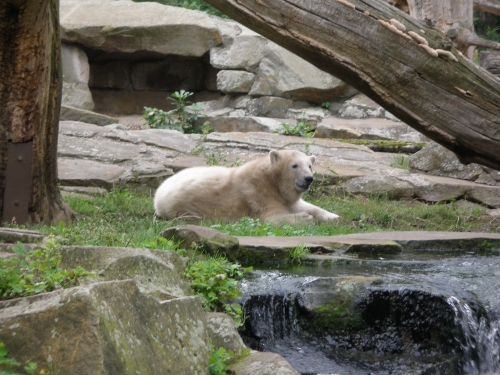
As you can see, Knut has grown considerably during the year
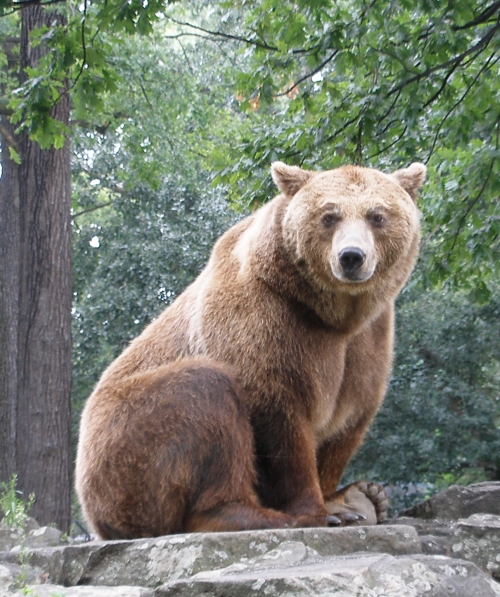
A big brown bear at Berlin Zoo

Chinstrap penguins are considering whether to take a dip

The Gedaechniskirche church
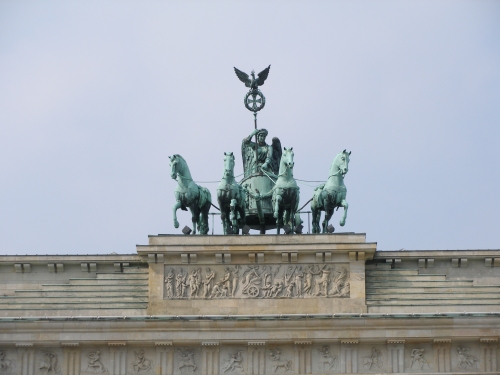
The Goddess of Victory on the Brandenburg Gate
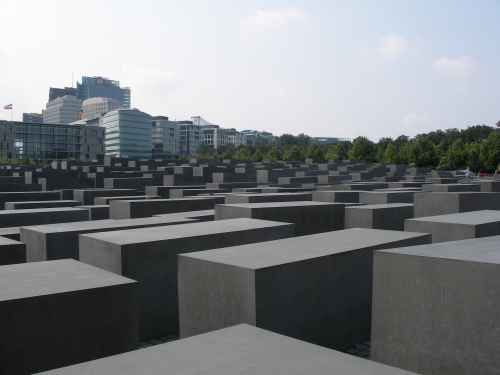
The Jewish holocaust memorial

The British Embassy
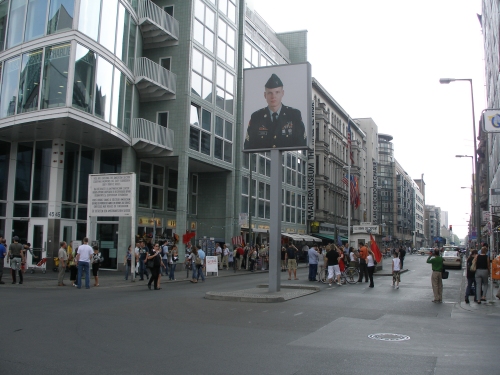
Checkpoint Charlie
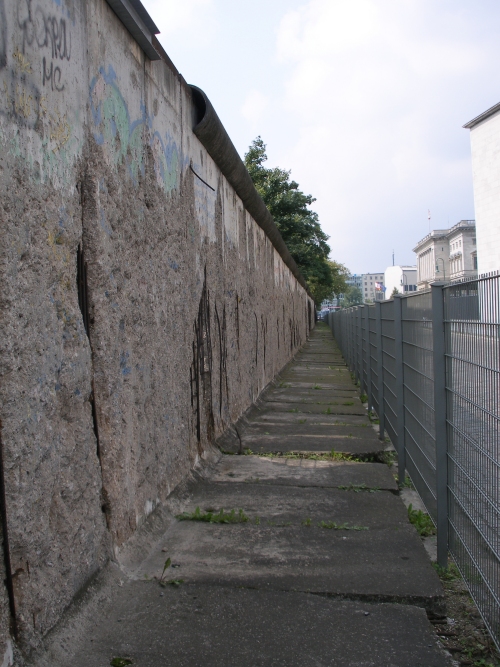
A preserved stretch of the Berlin Wall

Lenin's likeness can still be found on the side of buildings in 'East'
Berlin

The Reichstag building